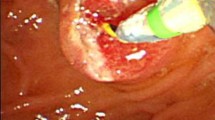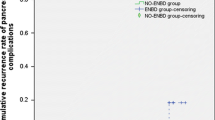Abstract
Background
Endoscopic papillary balloon dilation (EPBD) is a less hazardous alternative to endoscopic sphincterotomy for managing bile duct stones in patients with a coagulopathy. However, little information on EPBD is available for patients with bile duct stones who are undergoing hemodialysis (HD). We aimed to evaluate the safety and efficacy of EPBD for such patients.
Patients
This was a retrospective cohort study with prospectively collected data for 37consecutive patients with bile duct stones who were undergoing HD and who also underwent EPBD between December 1995 and April 2010 at four institutions in Tokyo, Japan. The main outcome was the safety and efficacy of EPBD for managing bile duct stones in patients undergoing HD.
Results
The bile duct stones were completely removed in one session in 24 patients (64.8%). Overall success was achieved using EPBD alone in all patients. Complications occurred in five patients (13.5%), including two with hemorrhage (5.4%). No hemorrhage developed in any of the 33 patients who had no additional bleeding risk except for HD. Pancreatitis and perforation developed in two (5.4%) and one (2.7%) patient, respectively.
Conclusions
EPBD seems to be a safe and effective treatment to extract bile duct stones in patients undergoing HD. However, EPBD should be performed carefully in patients with additional bleeding risk factors, such as Child–Pugh class C liver cirrhosis and those taking anti-platelet agents at the time of EPBD.
Similar content being viewed by others
Abbreviations
- HD:
-
Hemodialysis
- ERCP:
-
Endoscopic retrograde cholangiopancreatography
- EPBD:
-
Endoscopic papillary balloon dilation
- EST:
-
Endoscopic sphincterotomy
References
Gallstones and laparoscopic cholecystectomy. NIH Consens Statement. 1992;10:1–28.
Hermann RE. The spectrum of biliary stone disease. Am J Surg. 1989;158:171–3.
Rhodes M, Sussman L, Cohen L, Lewis MP. Randomised trial of laparoscopic exploration of common bile duct versus postoperative endoscopic retrograde cholangiography for common bile duct stones. Lancet. 1998;351:159–61.
Hahm JS, Lee HL, Park JY, Eun CS, Han DS, Choi HS. Prevalence of gallstone disease in patients with end-stage renal disease treated with hemodialysis in Korea. Hepatogastroenterology. 2003;50:1792–5.
Kazama JJ, Kazama S, Koda R, Yamamoto S, Narita I, Gejyo F. The risk of gallbladder stone formation is increased in patients with predialysis chronic kidney disease but not those undergoing chronic hemodialysis therapy. Nephron Clin Pract. 2009;111:c167–72.
Cotton PB, Geenen JE, Sherman S, Cunningham JT, Howell DA, Carr-Locke DL, et al. Endoscopic sphincterotomy for stones by experts is safe, even in younger patients with normal ducts. Ann Surg. 1998;227:201–4.
Vaira D, D’Anna L, Ainley C, Dowsett J, Williams S, Baillie J, et al. Endoscopic sphincterotomy in 1000 consecutive patients. Lancet. 1989;2:431–4.
Freeman ML, Nelson DB, Sherman S, Haber GB, Herman ME, Dorsher PJ, et al. Complications of endoscopic biliary sphincterotomy. N Engl J Med. 1996;335:909–18.
Loperfido S, Angelini G, Benedetti G, Chilovi F, Costan F, De Berardinis F, et al. Major early complications from diagnostic and therapeutic ERCP: a prospective multicenter study. Gastrointest Endosc. 1998;48:1–10.
Masci E, Toti G, Mariani A, Curioni S, Lomazzi A, Dinelli M, et al. Complications of diagnostic and therapeutic ERCP: a prospective multicenter study. Am J Gastroenterol. 2001;96:417–23.
Nelson DB, Freeman ML. Major hemorrhage from endoscopic sphincterotomy: risk factor analysis. J Clin Gastroenterol. 1994;19:283–7.
Dhar A, Pattni SS, Monahan KJ, Vlavianos P, Westaby D, et al. Incidence rates of post-ERCP complications: a case control study in renal transplant recipients and dialysis patients. Gastrointest Endosc 2010;71(5):AB161–2.
Isayama H, Komatsu Y, Inoue Y, Toda N, Shiratori Y, Tsujino T, et al. Preserved function of the Oddi sphincter after endoscopic papillary balloon dilation. Hepatogastroenterology. 2003;50:1787–91.
Komatsu Y, Kawabe T, Toda N, Ohashi M, Isayama M, Tateishi K, et al. Endoscopic papillary balloon dilation for the management of common bile duct stones: experience of 226 cases. Endoscopy. 1998;30:12–7.
Tsujino T, Kawabe T, Komatsu Y, Yoshida H, Isayama H, Sasaki T, et al. Endoscopic papillary balloon dilation for bile duct stone: immediate and long-term outcomes in 1000 patients. Clin Gastroenterol Hepatol. 2007;5:130–7.
Ito Y, Tsujino T, Togawa O, Yamamoto N, Isayama H, Nakata R, et al. Endoscopic papillary balloon dilation for the management of bile duct stones in patients 85 years of age and older. Gastrointest Endosc. 2008;68:477–82.
Kawabe T, Komatsu Y, Tada M, Toda N, Ohashi M, Shiratori Y, et al. Endoscopic papillary balloon dilation in cirrhotic patients: removal of common bile duct stones without sphincterotomy. Endoscopy. 1996;28:694–8.
Park DH, Kim MH, Lee SK, Lee SS, Choi JS, Song MH, et al. Endoscopic sphincterotomy vs. endoscopic papillary balloon dilation for choledocholithiasis in patients with liver cirrhosis and coagulopathy. Gastrointest Endosc. 2004;60:180–5.
K/DOQI clinical practice guidelines for chronic kidney disease: evaluation, classification, and stratification. Am J Kidney Dis. 2002;39:S1–266.
Tsujino T, Kawabe T, Isayama H, Sasaki T, Kogure H, Togawa O, et al. Efficacy and safety of low-pressured and short-time dilation in endoscopic papillary balloon dilation for bile duct stone removal. J Gastroenterol Hepatol. 2008;23:867–71.
Akizawa T, Koshikawa S, Ota K, Kazama M, Mimura N, Hirasawa Y. Nafamostat mesilate: a regional anticoagulant for hemodialysis in patients at high risk for bleeding. Nephron. 1993;64:376–81.
Cotton PB, Lehman G, Vennes J, Geenen JE, Russell RC, Meyers WC, et al. Endoscopic sphincterotomy complications and their management: an attempt at consensus. Gastrointest Endosc. 1991;37:383–93.
Sabovic M, Salobir B, Preloznik Zupan I, Bratina P, Bojec V, Buturovic Ponikvar J. The influence of the haemodialysis procedure on platelets, coagulation and fibrinolysis. Pathophysiol Haemost Thromb. 2005;34:274–8.
Salobir B, Sabovic M, Zupan IP, Ponikvar JB. Platelet (dys)function and plasma plasminogen levels in hemodialysis patients. Ther Apher Dial. 2008;12:133–6.
de Jager DJ, Grootendorst DC, Jager KJ, van Dijk PC, Tomas LM, Ansell D, et al. Cardiovascular and noncardiovascular mortality among patients starting dialysis. JAMA. 2009;302:1782–9.
Ethier J, Bragg-Gresham JL, Piera L, Akizawa T, Asano Y, Mason N, et al. Aspirin prescription and outcomes in hemodialysis patients: the Dialysis Outcomes and Practice Patterns Study (DOPPS). Am J Kidney Dis. 2007;50:602–11.
Prat F, Tennenbaum R, Ponsot P, Altman C, Pelletier G, Fritsch J, et al. Endoscopic sphincterotomy in patients with liver cirrhosis. Gastrointest Endosc. 1996;43:127–31.
Pillarisetti J, Patel P, Duthuluru S, Roberts J, Chen W, Genton R, et al. Cardiac catheterization in patients with end-stage liver disease: safety and outcomes. Catheter Cardiovasc Interv. 2011;77:45–8.
Disario JA, Freeman ML, Bjorkman DJ, Macmathuna P, Petersen BT, Jaffe PE, et al. Endoscopic balloon dilation compared with sphincterotomy for extraction of bile duct stones. Gastroenterology. 2004;127:1291–9.
Fujita N, Maguchi H, Komatsu Y, Yasuda I, Hasebe O, Igarashi Y, et al. Endoscopic sphincterotomy and endoscopic papillary balloon dilatation for bile duct stones: a prospective randomized controlled multicenter trial. Gastrointest Endosc. 2003;57:151–5.
Vlavianos P, Chopra K, Mandalia S, Anderson M, Thompson J, Westaby D. Endoscopic balloon dilatation versus endoscopic sphincterotomy for the removal of bile duct stones: a prospective randomised trial. Gut. 2003;52:1165–9.
Tsujino T, Isayama H, Komatsu Y, Ito Y, Tada M, Minagawa N, et al. Risk factors for pancreatitis in patients with common bile duct stones managed by endoscopic papillary balloon dilation. Am J Gastroenterol. 2005;100:38–42.
Conflict of interest
The authors declare that they have no conflict of interest.
Author information
Authors and Affiliations
Corresponding author
Rights and permissions
About this article
Cite this article
Takahara, N., Isayama, H., Sasaki, T. et al. Endoscopic papillary balloon dilation for bile duct stones in patients on hemodialysis. J Gastroenterol 47, 918–923 (2012). https://doi.org/10.1007/s00535-012-0551-x
Received:
Accepted:
Published:
Issue Date:
DOI: https://doi.org/10.1007/s00535-012-0551-x




